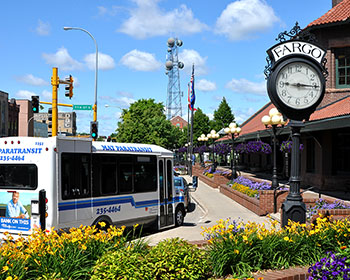Research Reports
Report Details
Abstract
 This report investigates public transportation's impact on food insecurity in North Dakota's rural and small urban areas, defining "small urban" as cities with 2,500 to 49,999 people. It highlights how limited public transport exacerbates food access issues, scrutinizing the potential of transit systems to enhance access to healthy foods and lessen dependence on personal or shared rides. The analysis delves into the Supplemental Nutrition Assistance Program (SNAP) and its role in mitigating food insecurity, despite persistent challenges across the state. It particularly focuses on child food insecurity and its association with Native American populations and poverty, identifying counties like Rolette, Benson, Sioux, and Ramsey with high food insecurity rates. The report reveals a lack of sufficient public transit in rural areas, complicating access to food sources such as supermarkets and food banks, which are vital in addressing hunger. It also examines food store distribution, noting disparities in rural counties. The relationship between food accessibility, poverty, and food insecurity, especially in Native American territories, is explored. The findings stress the need for improved transportation and access to healthy foods as strategies to combat food insecurity. Aimed at policymakers and stakeholders, the report calls for targeted interventions to ensure access to affordable, nutritious food, highlighting transportation and food assistance programs as key solutions.
This report investigates public transportation's impact on food insecurity in North Dakota's rural and small urban areas, defining "small urban" as cities with 2,500 to 49,999 people. It highlights how limited public transport exacerbates food access issues, scrutinizing the potential of transit systems to enhance access to healthy foods and lessen dependence on personal or shared rides. The analysis delves into the Supplemental Nutrition Assistance Program (SNAP) and its role in mitigating food insecurity, despite persistent challenges across the state. It particularly focuses on child food insecurity and its association with Native American populations and poverty, identifying counties like Rolette, Benson, Sioux, and Ramsey with high food insecurity rates. The report reveals a lack of sufficient public transit in rural areas, complicating access to food sources such as supermarkets and food banks, which are vital in addressing hunger. It also examines food store distribution, noting disparities in rural counties. The relationship between food accessibility, poverty, and food insecurity, especially in Native American territories, is explored. The findings stress the need for improved transportation and access to healthy foods as strategies to combat food insecurity. Aimed at policymakers and stakeholders, the report calls for targeted interventions to ensure access to affordable, nutritious food, highlighting transportation and food assistance programs as key solutions.



 This report investigates public transportation's impact on food insecurity in North Dakota's rural and small urban areas, defining "small urban" as cities with 2,500 to 49,999 people. It highlights how limited public transport exacerbates food access issues, scrutinizing the potential of transit systems to enhance access to healthy foods and lessen dependence on personal or shared rides. The analysis delves into the Supplemental Nutrition Assistance Program (SNAP) and its role in mitigating food insecurity, despite persistent challenges across the state. It particularly focuses on child food insecurity and its association with Native American populations and poverty, identifying counties like Rolette, Benson, Sioux, and Ramsey with high food insecurity rates. The report reveals a lack of sufficient public transit in rural areas, complicating access to food sources such as supermarkets and food banks, which are vital in addressing hunger. It also examines food store distribution, noting disparities in rural counties. The relationship between food accessibility, poverty, and food insecurity, especially in Native American territories, is explored. The findings stress the need for improved transportation and access to healthy foods as strategies to combat food insecurity. Aimed at policymakers and stakeholders, the report calls for targeted interventions to ensure access to affordable, nutritious food, highlighting transportation and food assistance programs as key solutions.
This report investigates public transportation's impact on food insecurity in North Dakota's rural and small urban areas, defining "small urban" as cities with 2,500 to 49,999 people. It highlights how limited public transport exacerbates food access issues, scrutinizing the potential of transit systems to enhance access to healthy foods and lessen dependence on personal or shared rides. The analysis delves into the Supplemental Nutrition Assistance Program (SNAP) and its role in mitigating food insecurity, despite persistent challenges across the state. It particularly focuses on child food insecurity and its association with Native American populations and poverty, identifying counties like Rolette, Benson, Sioux, and Ramsey with high food insecurity rates. The report reveals a lack of sufficient public transit in rural areas, complicating access to food sources such as supermarkets and food banks, which are vital in addressing hunger. It also examines food store distribution, noting disparities in rural counties. The relationship between food accessibility, poverty, and food insecurity, especially in Native American territories, is explored. The findings stress the need for improved transportation and access to healthy foods as strategies to combat food insecurity. Aimed at policymakers and stakeholders, the report calls for targeted interventions to ensure access to affordable, nutritious food, highlighting transportation and food assistance programs as key solutions.